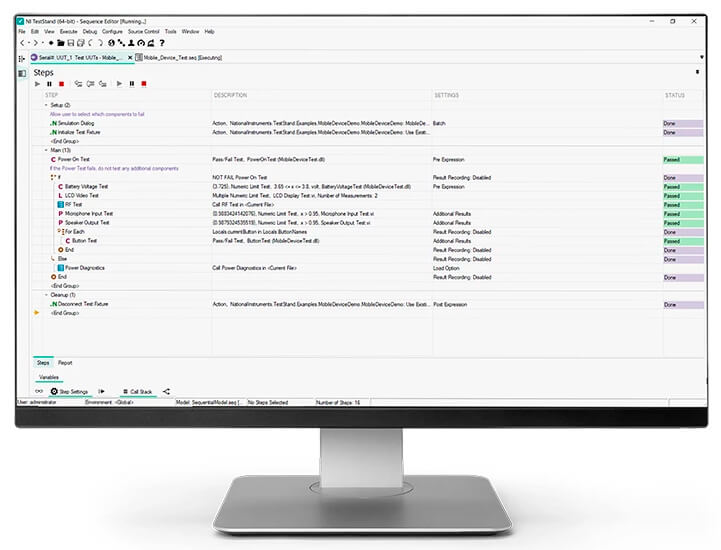
As we’ve discussed, data is the fuel for the right business decisions. If you want your team to make informed decisions, you need to collect, store, and analyze data. You may even want to collect a wide range of data that you don’t necessarily need to analyze or store. What do you do with all of this data? How do you organize it? Where do you store it? And how do you get your team to actually use it?
In production test, the key to achieving success is using standardized processes, systems, and data to improve development productivity, test station design quality, and operational efficiency.
Way too often most of the test data ends up being stored in a database on a hard drive unused or gets deleted. One reason for this is that many design teams see tests as a necessary evil, a step that slows their innovation and slows getting it to market. But this can be exactly the other way around: data can help find valuable insights that improve your product processes and even the product design itself. As Shelley Gretlein, NI’s Vicepresident of Software Strategy, puts it “You can feed your test data into simulations and improve their accuracy. You can feed valuable test data into manufacturing operations to find bottlenecks. You can increase your product quality and, paradoxically, you can actually decrease the time to market. Tests can speed things up, not slow them down.”
Having an integrated data strategy will improve your product quality
A test data strategy is important to ensure that your test data is valid, relevant, and up-to-date. Having an integrated data strategy will ensure that all your test data is consistent and valid. This will make it easier to identify bugs and make changes to your software. If you don’t have an integrated data strategy, you will find it difficult to track down bugs or problems. Having an integrated data strategy will also make it easier for your engineers and designers to find the data they need. This will prevent confusion and make it easier for teams to locate the information they require.
Having an integrated data strategy is not about acquiring more and more data: you probably have already a lot of data, so the key is how you are using your test data? For your data to actually be relevant, you must connect it and analyze it to get to actionable insights. The point isn’t just to generate it but identify the right data for the decisions you’re trying to make.
There are 3 questions you can ask yourself to assess whether you are using the data you have to its full potential:
- Does the data you collect lead to actionable insights on a weekly basis?
- Do you have a centralized function looking at the data across your product life cycle?
- Does everyone who could benefit have access to your data in a meaningful way?
If you answered no to any of these, you have an opportunity to improve how you are using your test data.
Use automated testing processes for your manufacturing test
A key area for data use is process optimization. Having a holistic data approach allows you to go into process optimization with a “clean slate” type of mindset: instead of focusing on just one area of efficiency that you want to improve, you can zoom out and look at the whole process and look at all of the data holistically, probably finding more areas to improve, thus achieving more savings. There’s a real case of a lighting company that found out that an intermittent network error was triggering a series of events that was causing perfectly good products to fail. They never thought there would be a connection between the IT infrastructure and their manufacturing process, but that was the cause of the manufacturing error.
Another key to the optimization of manufacturing processes is automated testing. It makes the process faster, more consistent, and more effective. Automated testing will also reduce the cost of testing and the time it requires.
In the case of electronics devices testing, an additional complication nowadays is the need to validate and test wireless devices, which requires testing and validation of ever-evolving wireless standards. The best approach to this complication might be using a software-defined option, and using a modular platform, such as industry-standard OXI, where you can use multiple modular instruments and signal I/O with timing and synchronization in a single chassis, which helps you avoid needing multiple bench-top instruments that take up space and are less flexible to manage.
Using data for better simulations
Another key way of leveraging manufacturing test data is to create more accurate simulations. By combining your test data with other data, you can create more realistic simulations. This is especially useful for industries such as aviation or space, where you cannot test in the actual environment and need to create simulations that are as close to the real thing as possible. In these cases you need to rely on simulations derived from known data.
Simulation is also very helpful when you are developing a very complex product or application and you have a tight deadline. Autonomous driving is a good example of this: if we had to rely on test tracks to build the autonomy and figure out the algorithms, it could take a hundred years to train those algorithms. Simulations can save massive amounts of time and also they enable testing products more thoroughly than ever before. But in order to build accurate simulations you need good data, and that date comes from test.
Getting to zero defects
The aim of manufacturing test is to produce high-quality products. The key to getting to zero defects is not just to discover the defects very quickly, but to discover them before they become a problem, and for that you need to have a fully connected data system: the best way to do this is by integrating your test data into your production workflow.
The end goal is predictive decision making. Rather than just understanding more about the test failures and the process optimizations, our end game is to predict and prevent failures before they ever occur.
To learn more about production test data optimization, contact SAAB RDS to get in touch with one of our experts.

